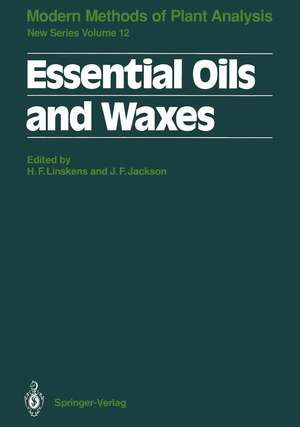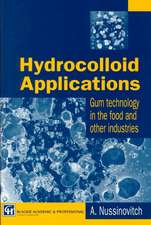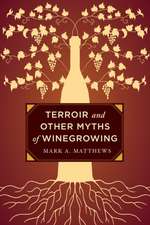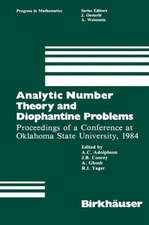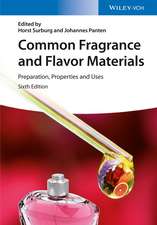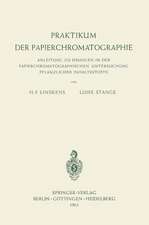Essential Oils and Waxes: Molecular Methods of Plant Analysis, cartea 12
Editat de Hans F. Linskens Contribuţii de R.P. Adams Editat de John F. Jackson Contribuţii de M.E. Crespo, S.G. Deans, H.E.M. Dobson, P. Dunlop, C.A.J. Erdelmeier, A. Ghosh, E.G. Hammond, R. B. Inman, J.F. Jackson, J. Jimenez, M. Kawakami, A.D. Kinghorn, A. Kiritsakis, A. Kobayashi, S. Kokkini, H.F. Linskens, P. Markakis, J. Metzger, S. Misra, C. Navarro, L.A.C. Pieters, C. Tringali, T.A. van Beek, G. Vernin, A.J. Vlietinck, Y. Yokouchien Limba Engleză Paperback – 27 dec 2011
Din seria Molecular Methods of Plant Analysis
- 15%
 Preț: 649.54 lei
Preț: 649.54 lei - 15%
 Preț: 648.42 lei
Preț: 648.42 lei - 15%
 Preț: 643.16 lei
Preț: 643.16 lei - 18%
 Preț: 1228.77 lei
Preț: 1228.77 lei - 15%
 Preț: 642.36 lei
Preț: 642.36 lei - 15%
 Preț: 638.57 lei
Preț: 638.57 lei - 15%
 Preț: 636.12 lei
Preț: 636.12 lei - 15%
 Preț: 637.13 lei
Preț: 637.13 lei - 15%
 Preț: 634.68 lei
Preț: 634.68 lei - 18%
 Preț: 950.33 lei
Preț: 950.33 lei - 15%
 Preț: 637.93 lei
Preț: 637.93 lei - 18%
 Preț: 947.50 lei
Preț: 947.50 lei - 18%
 Preț: 950.33 lei
Preț: 950.33 lei - 18%
 Preț: 1219.01 lei
Preț: 1219.01 lei - 18%
 Preț: 1219.31 lei
Preț: 1219.31 lei - 15%
 Preț: 643.99 lei
Preț: 643.99 lei - 15%
 Preț: 641.71 lei
Preț: 641.71 lei - 15%
 Preț: 641.03 lei
Preț: 641.03 lei - 15%
 Preț: 648.24 lei
Preț: 648.24 lei - 15%
 Preț: 645.60 lei
Preț: 645.60 lei -
 Preț: 399.67 lei
Preț: 399.67 lei - 15%
 Preț: 647.08 lei
Preț: 647.08 lei
Preț: 896.84 lei
Preț vechi: 1093.70 lei
-18% Nou
Puncte Express: 1345
Preț estimativ în valută:
171.62€ • 183.51$ • 143.09£
171.62€ • 183.51$ • 143.09£
Carte tipărită la comandă
Livrare economică 17 aprilie-01 mai
Preluare comenzi: 021 569.72.76
Specificații
ISBN-13: 9783642840258
ISBN-10: 3642840256
Pagini: 360
Ilustrații: XVIII, 337 p.
Dimensiuni: 170 x 242 x 19 mm
Greutate: 0.61 kg
Ediția:Softcover reprint of the original 1st ed. 1991
Editura: Springer Berlin, Heidelberg
Colecția Springer
Seria Molecular Methods of Plant Analysis
Locul publicării:Berlin, Heidelberg, Germany
ISBN-10: 3642840256
Pagini: 360
Ilustrații: XVIII, 337 p.
Dimensiuni: 170 x 242 x 19 mm
Greutate: 0.61 kg
Ediția:Softcover reprint of the original 1st ed. 1991
Editura: Springer Berlin, Heidelberg
Colecția Springer
Seria Molecular Methods of Plant Analysis
Locul publicării:Berlin, Heidelberg, Germany
Public țintă
ResearchCuprins
Olive Oil Analysis.- 1 Introduction.- 2 Quality Tests of Olive Oil-Determination of Acidity and Oxidation.- 3 Sensory Evaluation of Olive Oil.- 4 Determination of Certain Constituents of Olive Oil.- 5 Moisture Determination.- 6 Determination of Soap Content.- 7 Olive Oil Adulteration — Adulteration and Genuineness Tests.- References.- Analysis of Essential Oils of Tea.- 1 Introduction.- 2 Isolation of Essential Oils.- 3 Separation and Identification of Essential Oil Components from Tea.- 4 Components of the Essential Oil.- 5 Pattern Analyses of Gas Chromatograms.- References.- Special Methods for the Essential Oils of the Genus Thymus.- 1 Introduction.- 2 Plant Material.- 3 Extraction.- 4 Analytical Methodology.- 5 Conclusions.- References.- Chemical Races Within the Genus Mentha. L..- 1 Introduction.- 2 Biosynthesis of Mentha Essential Oils.- 3 Chemical Races.- 4 Conclusions.- References.- Special Methods for the Essential Oil of Ginger.- 1 Introduction.- 2 Traditional Methods of Extraction, Separation, and Control.- 3 Modern Methods of Extraction, Separation, and Identification.- References.- GC-MS (EI, DCI, NCI, SIM) SPECMA Bank Analysis of Volatile Sulfur Compounds in Garlic Essential Oils.- 1 A Short Survey of the Chemistry of Garlic.- 2 Analytical Methods Used for Identification of Sulfur Compounds in Garlic Essential Oil.- 3 GC-MS Analyses of Two Garlic Essential Oils Originating from France (Provence) and Mexico.- 4 Conclusion.- References.- Analysis of Juniper and Other Forest Tree Oil.- 1 Introduction.- 2 Sample Collection.- 3 Oil Extraction.- 4 Chemical Analysis.- 5 Component Identification.- 6 Applications of Terpenoid Data.- References.- Cedar Wood Oil — Analyses and Properties.- 1 Introduction.- 2 Sample Collection.- 3 Oil Extraction.- 4 ChemicalAnalysis.- 5 Identification.- 6 Properties.- References.- Analysis of Croton Oil by Reversed-Phase Overpressure-Layer Chromatography.- 1 Introduction — Overpressure-Layer Chromatography as a Separatory Technique.- 2 Phorbol Ester Constituents of Croton Oil.- 3 Separation of the Phorbol Esters of Croton Oil.- 4 Summary and Conclusions.- References.- Rotation Locular Countercurrent Chromatography Analysis of Croton Oil.- 1 Introduction.- 2 Croton Oil, the Seed Oil of Croton tiglium.- 3 RLCC Analysis of Croton Oil.- 4 Summary and Conclusion.- References.- Oils and Waxes of Eucalypts Vacuum Distillation Methodl for Essential Oils.- 1 Introduction.- 2 Chemical Composition of Eucalyptus Oils and Waxes.- 3 Methods of Analyses of Eucalyptus Waxes.- 4 Methods of Analysis of Eucalyptus Oils.- 5 Vacuum Distillation Method for Essential Oils.- References.- Analysis of Epicuticular Waxes.- 1 Introduction.- 2 Extraction of Epicuticular Wax.- 3 Fractionation of Wax Components.- 4 Analysis of Wax Components.- 5 Conclusion.- References.- Analysis of Flower and Pollen Volatiles.- 1 Introduction.- 2 Flower Volatile Chemistry.- 3 Overview of Methodology.- 4 Details of Collection Methods.- References.- Bioactivities of Diterpenoids from Marine Algae.- 1 Introduction.- 2 Antimicrobial Activity.- 3 Antialgal Activity.- 4 Cytotoxic Activity and Other Related Activities.- 5 Ichthyotoxicity and Other Defensive Bioactivities.- 6 Molluscicidal Activity.- 7 Other Bioactivity Data on Diterpenoids from Seaweeds.- 8 Concluding Remarks.- References.- Determination of Waxes Causing Water Repellency in Sandy Soils.- 1 Introduction.- 2 Assessment of Water Repellency of Soils.- 3 Extraction of Water-Repellent Waxes.- 4 Significance and Conclusions.- References.- Analysis of Monoterpene Hydrocarbons inthe Atmosphere.- 1 Introduction.- 2 Sampling and Concentration.- 3 GC, GC/MS Method.- 4 Calibration.- 5 Features of Atmospheric Monoterpenes.- References.- Evaluation of Antimicrobial Activity of Essential (Volatile) Oils.- 1 Introduction.- 2 Extraction of Plant Volatile Oil.- 3 Evaluation of Antimicrobial Properties of Volatile Oils.- 4 Antimicrobial Activity of Volatile Oils.- 5 Future Developments in Volatile Oils.- References.- Organization of Rapid Analysis of Lipids in Many Individual Plants.- 1 Introduction.- 2 Analyses for Total Lipid Content.- 3 Analyses for Fatty Acid Composition.- 4 Analyses for Glyceride Structure.- 5 Analyses for Other Lipid Constituents.- 6 Analyses for Lipoxygenase.- References.
